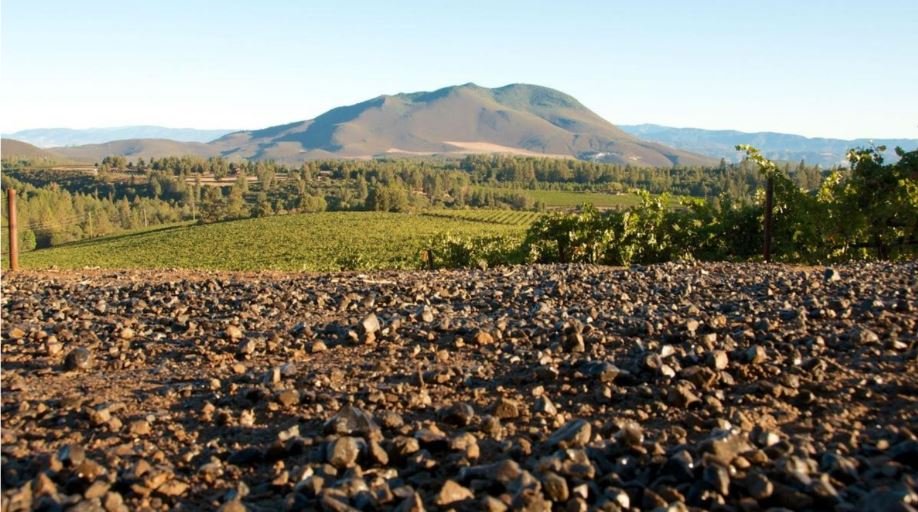Volcanic, high elevation vineyards produce small grapes with thick skins
Insight from author Sam Jones regarding Lake County’s volcanic soil from the Napa Valley Wine Insider Digest, featuring an excerpt from Bryan Kane at Sol Rouge Vineyard & Winery.
Sam Jones - Napa Valley Wine Insider Digest
In his winemaking, Arpad Molnar sources grapes from two very different extremes. The first — his father’s vineyard — lies at the base of the Mayacamas Mountains, and the second sits at 2,640 feet atop the volcanic soils of Red Lake County.
As one of their wine "adventures" experiences, Obsidian staff take visitors up to their volcanic vineyard and hike the surrounding area.
When first planting the latter, which would be named Obsidian Ridge, Molnar and the rest of the Obsidian viticulture crew weren’t entirely sure what they were getting into.
They knew that the site was near the Clear Lake Volcanic Field and that the towering Cobb Mountain and Mount Konocti would have some sort of impact on their grapes, but upon digging, they were shocked to find larger-than-life chunks of Obsidian beneath their soon-to-be-planted vineyard. After some major heavy lifting, the high-elevation and widely varied plot was planted, and a few years later, Obsidian had its first drinkable vintage.
“The hard part was waiting to see if the grapes were gonna be any good,” said Molnar. “That was the biggest leap for us.”
Since planting the Obsidian Ridge vineyard in 1999, Molnar and his employees in the field have learned a lot about adapting to the site’s harsh climate, which has a tendency to leave vines exposed to the elements due to the elevation level.
“We learned that it’s a lot drier up there, it’s a lot more UV and there’s a lot more extreme weather,” said Molnar. “What bodies of water do is that they modulate the weather, so up there, nothing is really demodulated so we have to leave the canopies much bigger and drape over the fruit.”
These high levels of UV radiation aren’t all bad though, as they do have a tendency to give the fruit many of the qualities emblematic of stereotypical “volcanic” wines.
“You have a lot of UV that is bouncing off the obsidian because it is glass, and so you get a lot of light into the fruit zone,” explained Molnar. “The reason you want that is because you get thicker skins and more flavor and color.”
These smaller berries with thicker skins — and thus an altered fruit-to-skin ratio — are what many vintners planting in Lake County are looking for. These vineyards don't have the Napa Valley name, but this farmable land in Lake County tends to skew more affordable, and the terroir offers unique characteristics that some winemakers adore.
Hawk and Horse Vineyards, Peter Franus Wine Company, Brassfield Estate Winery, and Sol Rouge are among these Lake County volcanic soil establishments, in addition to Obsidian, which also has a Napa Valley tasting room.
“I've been farming in Lake County since 2009 and I love farming in the volcanic soils,” said Jonathan Walters of Brassfield Estate. “Lake County has young, nutrient-rich soils and they’re deeply uniform, and that allows the grapes to get small berries up at elevation.”
“Also, a lot of these sites are very well-drained which allows smaller berries, higher phenolics, anthocyanins ... Everything you want in a big red dark wine.”
Similarly, Bryan Kane of Sol Rouge manages his own vineyard, which is entirely covered in volcanic soils. Having worked on both Howell Mountain and Diamond Mountain, though, elevation wasn’t new to this vintner — he actually prefers it to the valley floor.
“We don’t have this loamy clay type like they do down in the valley, so when it does rain, we don’t have the same problems,” he said. “Our soils drain very well, so it doesn’t puddle water [and] we don’t have the same issue with mold and mildew propagation.”
Additionally, Kane says these soils also allow the vines to go deeper into the ground searching for water, which he says results in a more robust root system.
“It’s pulling much more of the terroir and has a bigger structure, but it is producing the same amount of grapes on top,” he said, explaining the bitty-but-bold nature of high-elevation grapes.

